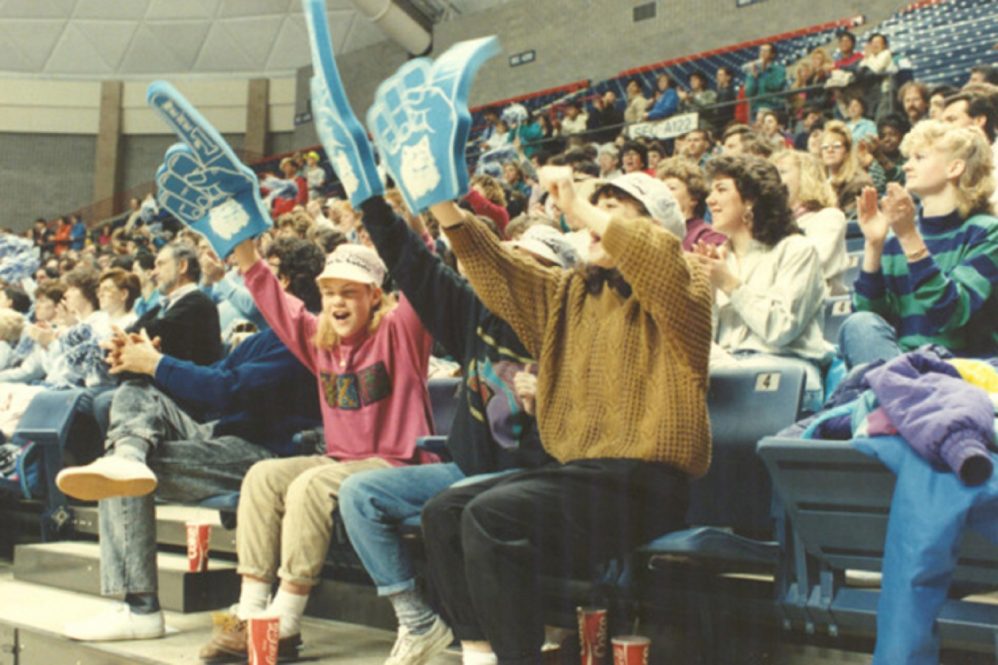Barbara Johnson, the famous literary critic, and translator, once said that “change is a process, not an event.” As the collegiate athletics world celebrates the 50th anniversary of Title IX, that notion of positive, lasting change taking time continues to ring true.
Pat Meiser, whose unique experience and perspective includes an 11-year stint as the associate athletic director for administration and senior woman administrator for the UConn athletic department, and 22 years as the director of athletics at the University of Hartford, acknowledges that “while great progress has been achieved, we have a long way to go.”
This weekend, that progress will be celebrated by hundreds of former UConn women student-athletes that are returning to the University on October 14-16 for a celebration of the 50th anniversary of Title IX and the commemoration of an enduring legacy of UConn women’s athletics since its varsity inception in 1974.
The Civil Rights Act of 1964 prohibited discrimination in the workplace at a wide array of institutions but did not apply to people working in education settings. Title VII was then enacted to apply this protection to educational institutions, private and public, that received federal funding, but somehow did not include women as a protected class. So, Title IX was signed into law by President Richard Nixon on June 23, 1972, to update Title VII and ensure equitable opportunities for women at educational institutions.
See Barbara Johnson quote above.
Following her graduation from West Chester University in 1969, Meiser enrolled at Penn State and earned her master’s degree in education in 1971. Perhaps there was some magic at West Chester waiting to be transported and unlocked in Storrs as UConn’s Hall of Fame field hockey and women’s basketball coaches, Diane Wright, Nancy Stevens and Geno Auriemma would follow in Meiser’s footsteps and earn their undergrad degrees from West Chester, in 1969, 1975 and 1977, respectively. A story for another day perhaps.

Meiser made an impression during her time State College and was hired as the head women’s basketball coach for Penn State’s junior varsity team in 1971. While the topic of gender equity in college athletics was a topic of conversation, and legislation to mitigate gender discrimination was in the public consciousness, Meiser was one of the many who could not envision just how impactful Title IX would be.
“I remember being informed of the passage of the legislation and that Penn State had until the beginning of the 1978-79 academic year to be in compliance,” Meiser says. “I think Penn State administration felt that, due to its high-profile football program and being only three-hours from Washington, D.C., the federal government would be paying attention to the progress the PSU athletic department was making towards compliance. To its credit, Penn State committed to becoming compliant with the legislation.”
Compliance meant that coaching would become a much more time-consuming endeavor and head varsity coach Mary Ann Domitrovitz, who was also a health and physical education teacher at the time, did not feel like she could commit to the new version of the job.
The job was offered to Meiser, who happily accepted. Penn State was committed, but the process was still an arduous one. Meiser likens the process to “the slowest moving ship ever!” But Penn State continued to work towards compliance and Meiser’s salary was increased significantly, and her team played a more robust and national schedule.
“The legislation was extremely punitive from a financial perspective if institutions did not take it seriously,” Meiser says. “Penn State was a model. For example, during my last season as an assistant coach we played eight games. By the 1978-79 we played 29 and competed against Tennessee, Texas and UCLA during a tournament in Miami. We lost those three games by a total of four points, but the opportunity for female athletes to compete at a very high level was becoming more and more available.”
Meiser served as Penn State’s head coach for six seasons, compiling a 92-52 overall record before deciding to pursue a career in administration, which led her to Storrs.
John Toner, who served as UConn’s director of athletics from 1969-87 and concurrently as the President of the NCAA from 1983-85 is often celebrated for hiring two basketball coaches, Auriemma and Jim Calhoun, who would put together hall of fame careers, and for accepting an invitation from a fledgling conference made up of six private institutions on the east coast. Those two decisions launched UConn athletics into a different stratosphere, but Meiser also remembers Toner for the high value he placed on providing equitable opportunities for female athletes.
“John was committed to women’s athletics,” Meiser says. “I remember watching him speak at an AIAW (Association for Intercollegiate Athletics for Women) event, outlining how the NCAA would reorganize itself to support women’s athletics. The crowd was not easily convinced and asked a lot of tough questions. But John had great resolve and was an advocate for women’s athletics once the NCAA became involved.”

For generations, college athletics, and sports in general had been dominated by males and aspiring administrators like Meiser did not have many female role models to look up to. But Meiser earned the opportunity to become one of those role models in 1983 when Toner offered her the position of associate athletic director for administration/senior woman administrator (SWA). The SWA designation was created in 1981 and intended to promote meaningful representation of women in the leadership and management of college sports, according to the NCAA.
“Penn State’s reputation for Title IX compliance was outstanding,” Meiser says. “I know John (Toner) wanted to use Penn State as a model in that area for UConn, so he called Joe Paterno who was also serving a short stint as Penn State’s AD. Joe recommended me to John for the position at UConn. John was smart enough to see where things were headed, and he partnered with me to take the appropriate action to ensure we were on the right track as it relates to equity.
“The commitment to equity was here when I started, but the money really wasn’t! Therefore, a new focus on department-wide fundraising became a priority. “
Meiser’s work at UConn for 11 years propelled her to new heights and she was named the director of athletics at the University of Hartford in 1993. At that time, she was one of only 11 female athletic directors at the NCAA Division I level.
“While great progress has been achieved, we have a long way to go.”
Meiser’s words continue to ring true and are supported by the fact that, according to data from 2021, only 50 of 358 NCAA Division I athletics programs are led by female athletic directors, and only five of the 65 programs that are members of the ACC, BIG 10, BIG 12, Pac-12, or the SEC are led by women.
As we celebrate the 50th anniversary of the passage of Title IX, it’s important to celebrate pioneers like Pat Meiser, and appreciate the fact that equity was a priority for UConn athletics dating back to the days of John Toner.
But a half century of progress should crystalize the fact that now is the perfect time to speed up that slow-moving boat.



